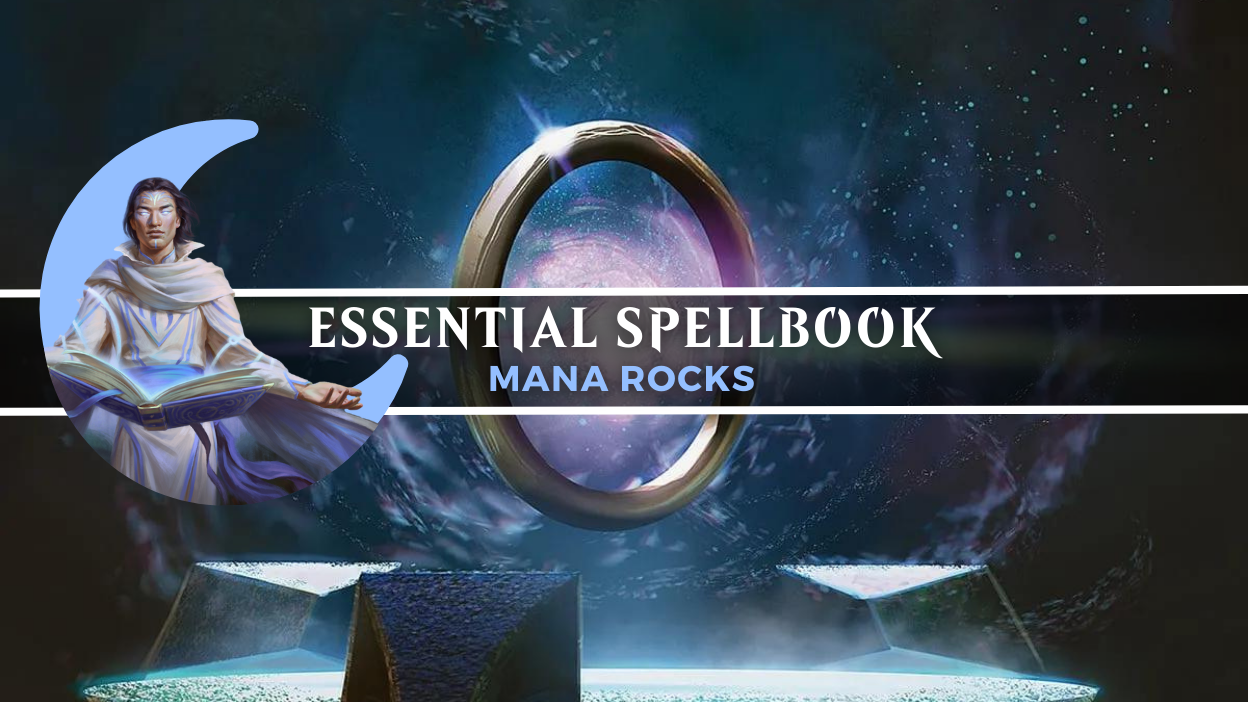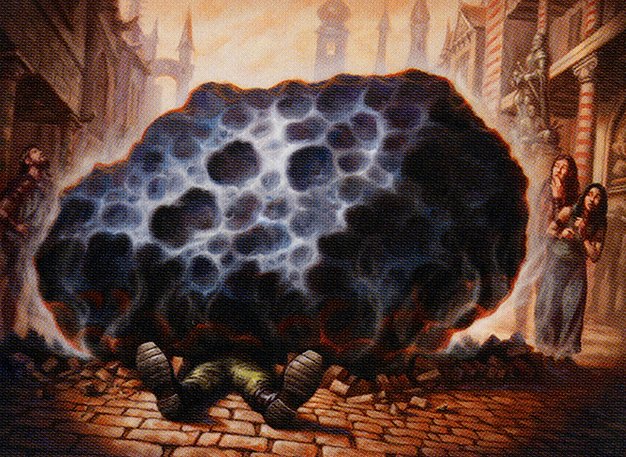Essential Spellbook - Mana Rocks

Rocks to Knock Your Socks Off
Let's pick up where we left off. The previous episode of Essential Spellbook presented a veritable salad bar of green cards. These cards provided ramp: access to additional mana beyond the mana available from playing one land per turn. Ramp is an essential element of almost every successful Commander deck because it allows you to cast expensive spells and make big plays earlier than your opponents.
However, once we look beyond green cards, options for ramp become more scarce. True, every color has access to cards that ramp, but these ramp effects are usually conditional (like Knight of the White Orchid
Because of this, many nongreen decks (and some green decks, too) rely on colorless cards to provide consistent, reliable mana acceleration, and by far the most common type of colorless ramp card is the humble mana rock.
What's a "Mana Rock?"
"Mana rock" is the colloquial term for any artifact that taps to produce mana. These cards provide a ramp solution that's appropriate for nearly any Commander deck. Some of these cards, like Sol Ring
In comparison to other forms of ramp, mana rocks are often very efficient. Unlike the previous article's land-based ramp and mana dorks, mana rocks can usually tap for mana the turn they're played. They're also available in a range of versatile flavors, sometimes tapping for multiple colors of mana
However, the efficiency and versatility of the humble mana rock is balanced by its relative fragility. In terms of vulnerability to removal, mana rocks fall somewhere between land-based ramp and mana dorks. They're not as fragile as creature-based ramp, like Elvish Mystic
Just as in the previous episode of Essential Spellbook, we're going to examine a representative card at each mana value and explore how it relates to other options at that mana value. Here we go!
Mana Value 1 or Less: Sol Ring
Love it or hate it, there's no more iconic card in Commander than Sol Ring
Sol Ring
- Mana Cryptis just Sol Ringbut slightly cheaper and slightly riskier. Not in a way that matters, though: you'll win before the damage kills you.
- Mana Vaultprovides a burst of mana, but then you need to pay mana to untap it. This card is a bit more niche than other options, but it's still very strong.
- Chrome Moxand Mox Diamondcost no mana, but they demand that you give up a card in your hand. They're incredibly strong cards and staples of the high-powered corners of the Commander format.
- Mox Opaland Mox Amberrequire a bit more setup before they provide mana, but the payoff is often worth the effort. Free mana is good, y'all.
(Okay, I lied. Not every mana rock that costs 1 mana or less is powerful. Springleaf Drum
When deciding whether to play these game-changing cards in your deck, you don't need to worry much about whether they're the right fit. Cards like Mana Crypt
The exception, by group consensus, is Sol Ring
Also, all of these cards are stupidly expensive, money-wise. Except for Sol Ring
Mana Value 2: Signets and Talismans
Mana rocks that cost two mana are defined by two broad sets of cards: the Signets (such as Azorius Signet
All of these cards tap for one mana (or one net mana, in the case of the Signets) while also providing access to multiple colors of mana. These little guys are the archetypal mana rocks: efficient, flexible, and suitable for almost every Commander deck.
Commander incorporates many, many other mana rocks with mana value 2, most of which trade some flexibility or efficiency for additional effects:
- Fellwar Stoneis nearly as good as Arcane Signetin a format that encourages multiplayer games with multicolored decks.
- Thought Vessel, Mind Stone, and Liquimetal Torqueonly produce colorless mana but provide small benefits unrelated to mana production.
- The diamond cycle (Marble Diamond, Sky Diamond, etc.) are inferior to Talismans and Signets but see play in mono-colored decks that can't play better mana rocks.
Like other ramp with mana value 2, these cards are especially valuable in decks with Commanders that cost 4 mana because they enable you to cast those spells on turn 3.
Mana Value 3: Commander's Sphere
Commander's Sphere
Some mana rocks in this category worth considering include:
- Worn Powerstoneenters tapped and only taps for colorless mana, but it makes two mana! It's like a fair Sol Ring!
- Chromatic Lanternensures you'll always have the wrong colors of mana to cast your spells. It's generally not necessary if you invest in your lands, but it has a home in budget decks with many colors.
- Decanter of Endless Wateris Thought Vessel's more stylish big sibling.
- Midnight Clockand Cursed Mirrorare restricted to one color, but they've got seriously powerful upsides in the right circumstances.
There are way more cards in this category than I can reasonably list in this article, but you can look through all of them here.
These cards often feel inefficient in comparison to rocks with mana value two, but sometimes the additional effects they offer are enough to compensate for their inflated cost. They're worth consideration in decks that care more about synergy than efficiency.
Mana Value 4 and beyond: Thran Dynamo
Once you're paying 4 or more mana for a mana rock, you'd better be getting something pretty great out of the deal. Like my representative pick, Thran Dynamo
Like mana rocks at mana value 3, these cards are too diverse to list in full, but here are some highlights:
- Hedron Archiveis two Mind Stones stapled together, and Dreamstone Hedronis three!
- Gilded Lotusand Timeless Lotusproduce plenty of colored mana.
- Throne of Eldraineand Nyx Lotusexcel in mono-colored decks.
- Coveted Jewel, a personal favorite, adds a bit of spice to Commander night.
These rocks rarely see play except in decks that are truly gluttonous for mana, but they're a very good option if your game plan is to quickly reach double digits of mana (and you're not playing green).
(Meteorite | Art by Scott Murphy)
Should I Play Mana Rocks?
As previously mentioned, mana rocks are an excellent way to ramp that's appropriate for almost every Commander deck. Some decks, however, are more likely to play mana rocks than others:
- Mana rocks especially excel in decks that care about artifacts, like Alela, Artful Provocateuror Osgir, the Reconstructor.
- High-powered decks tend to play many mana rocks, especially the powerful ones that cost 1 mana or less.
In contrast, certain considerations can incentivize a deckbuilder to choose other ramp cards instead of mana rocks:
- If your deck includes green cards, you may have access to ramp cards that are more resilientor more efficientthan mana rocks.
- If your deck's strategy synergizes with another category of ramp cards, like treasure-producersor cost-reducers, those cards may compete for the same space in your deck as mana rocks.
- If your deck (or your playgroup) incorporates many cards with the potential to wipe artifacts from the board, like Vandalblastor Cleansing Nova, mana rocks can be a liability in comparison to land-based ramp.
When it comes to choosing whether your deck wants rocks at mana value 2, mana value 3, or higher, many of the principles listed at the end of the previous episode of Essential Spellbook apply.
Putting the Rocks Back in the Box
Thank you for taking a tour of my rock collection. I hope you enjoyed the shine and sparkle.
Do you have a favorite mana rock that I neglected to mention like the fool that I am? Let me know!
